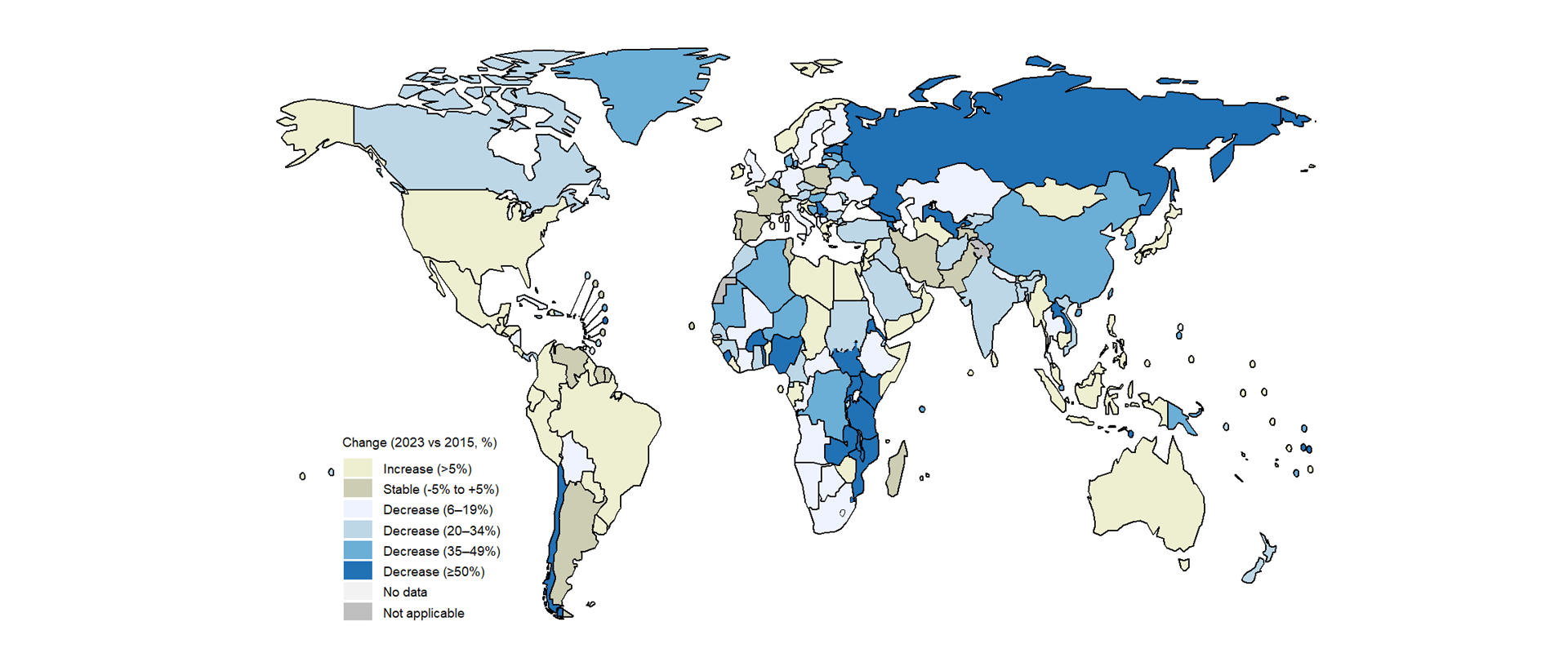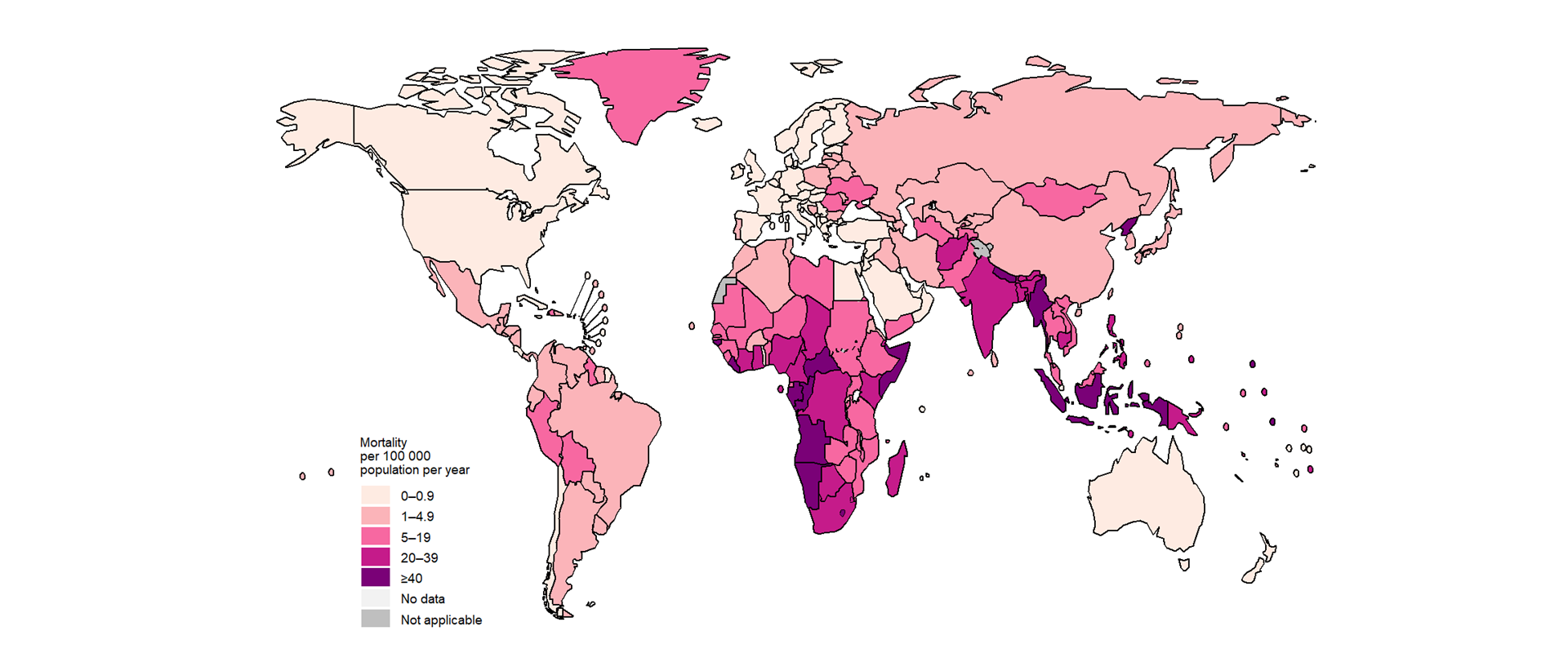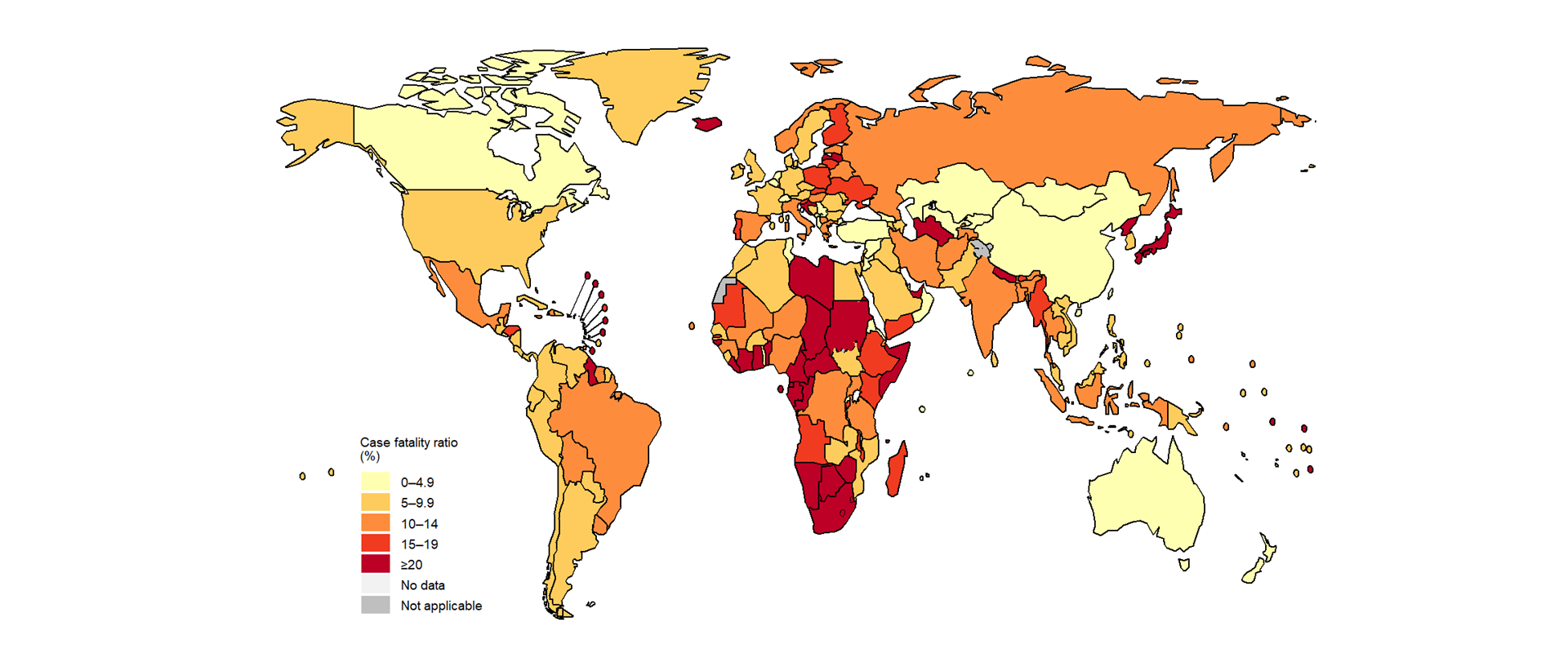
1.2 TB mortality
Box 1.2.1 summarizes the methods used to produce estimates of TB mortality between 2010 and 2023.
For consistency with international standards (1), this section makes a clear distinction between deaths from TB in people without HIV (classified as deaths caused by TB) and deaths from TB in people with HIV (classified as deaths caused by HIV, with TB as a contributory cause).
Globally, the annual number of deaths caused by TB fell between 2010 and 2019, but this trend was reversed in 2020 and 2021 (Fig. 1.2.1). The estimated increase in the number of deaths caused by TB in these two years was the consequence of disruptions to TB diagnosis and treatment during the COVID-19 pandemic, when the reported number of people newly diagnosed with TB fell from 7.1 million in 2019 to 5.8 million in 2020 and 6.4 million in 2021 (Section 2.1), suggesting a large increase in the number of people with undiagnosed and untreated TB. Following a strong global recovery in the number of people newly diagnosed with TB in 2022 and 2023 (Section 2.1), the estimated number of deaths caused by TB fell in both 2022 and 2023: the reduction in 2023 compared with 2021 was 12%, and 5.7% compared with 2022.
Globally in 2023, there were an estimated 1.09 million deaths among HIV-negative people (95% uncertainty interval [UI]: 0.98–1.2 million) and an estimated 161 000 deaths among people with HIV (95% UI: 132 000–193 000). The combined total of 1.25 million is lower than the level of 2019. However, the net reduction in the total number of deaths caused by TB between 2015 and 2023 was only 23%, far from the 2025 milestone of the WHO End TB Strategy (a 75% reduction between 2015 and 2025).
(a) Number
(b) Rate per 100 000 population
Disruptions during the COVID-19 pandemic and its aftermath are estimated to have resulted in close to 700 000 excess deaths from TB in the four years 2020–2023 (Fig. 1.2.2).
In 2023, most of the estimated deaths caused by TB among HIV-negative people occurred in the WHO regions of South-East Asia (54%) and Africa (27%), with smaller shares in the Western Pacific (8.1%), the Eastern Mediterranean (7.7%), the Americas (2.3%) and Europe (1.4%). Most of the TB deaths among people with HIV occurred in the African Region (Table 1.2.1).
| Region or country group | Best estimate | Low | High | Best estimate | Low | High | Best estimate | Low | High | Best estimate | Low | High |
|---|---|---|---|---|---|---|---|---|---|---|---|---|
| African Region | 291 | 252 | 333 | 112 | 84 | 145 | 24 | 20 | 27 | 9.1 | 6.8 | 12 |
| Region of the Americas | 25 | 23 | 27 | 10 | 8.5 | 12 | 2.4 | 2.2 | 2.6 | 0.97 | 0.82 | 1.1 |
| Eastern Mediterranean Region | 84 | 71 | 97 | 2.2 | 1.8 | 2.7 | 10 | 8.8 | 12 | 0.28 | 0.22 | 0.34 |
| European Region | 16 | 14 | 17 | 6.5 | 4.6 | 8.8 | 1.7 | 1.5 | 1.8 | 0.70 | 0.49 | 0.94 |
| South-East Asia Region | 583 | 485 | 690 | 23 | 19 | 26 | 28 | 23 | 33 | 1.1 | 0.92 | 1.2 |
| Western Pacific Region | 88 | 75 | 102 | 6.9 | 5.8 | 8.1 | 4.5 | 3.9 | 5.3 | 0.36 | 0.30 | 0.42 |
| High TB burden countries | 925 | 817 | 1 040 | 121 | 93 | 153 | 19 | 16 | 21 | 2.4 | 1.9 | 3.1 |
| Global | 1 090 | 977 | 1 200 | 161 | 132 | 193 | 13 | 12 | 15 | 2.0 | 1.6 | 2.4 |
Globally in 2023, 52% of the HIV-negative people who died from TB were men, 32% were women and 15% were children (aged <15 years) (Fig. 1.2.3). Of the TB deaths among people with HIV, 48% were men, 36% were women and 16% were children.
(a) Among HIV-negative people
(b) Among people with HIV
In 2023, an estimated total of 646 000 adult men (aged ≥15 years) died from TB (95% UI: 575 000–722 000): 568 000 among those HIV-negative (95% UI: 511 000–629 000) and 78 000 among those with HIV (95% UI: 63 000–93 000). An estimated total of 410 000 adult women (aged ≥15 years) died from TB (95% UI: 364 000–459 000): 352 000 among those HIV-negative (95% UI: 317 000–389 000) and 58 000 among those with HIV (95% UI: 47 000–70 000).
In 2023, an estimated total of 191 000 children and young adolescents (<15 years) died from TB (95% UI: 170 000–214 000): 166 000 among those HIV-negative (95% UI: 149 000–184 000) and 25 000 among those with HIV (95% UI: 21 000–30 000). Among HIV-negative children and young adolescents, the estimated number of TB deaths in 2023 was 122 000 among children aged <5 years (95% UI: 110 000–135 000); and 44 000 in older children and young adolescents aged 5–14 years (95% UI: 39 000–48 000).
The latest year for which WHO has published estimates of global deaths by cause is 2021. TB was the tenth leading cause of death worldwide (Fig. 1.2.4). In the African and South-East Asia regions, it was the fourth and fifth leading cause of death, respectively. Now that COVID-19 has receded as a global public health emergency, in 2023 TB probably returned to being the leading cause of death from a single infectious agent. In 2023, a total of 320 000 deaths from COVID-19 were officially reported; however, this does not account for late reporting and underreporting (2).
b Deaths from TB among people with HIV are officially classified as deaths caused by HIV/AIDS in the International Classification of Diseases.
The estimated number of deaths officially classified as caused by TB (i.e. those among HIV-negative people) in 2023, at 1.1 million, was almost double of the number of deaths caused by HIV/AIDS (0.63 million) (Fig. 1.2.5).
b Deaths from TB among people with HIV are officially classified as deaths caused by HIV/AIDS in the International Classification of Diseases.
Compared with HIV, deaths from TB were much more severely impacted by the COVID-19 pandemic (Fig. 1.2.6). In contrast to TB, there was a persistent decline in deaths from HIV/AIDS throughout the period 2020–2023 (3).
b Deaths from TB among people with HIV are officially classified as deaths caused by HIV/AIDS in the International Classification of Diseases.
In 2023, the TB mortality rate fell in the Region of the Americas after two consecutive years of increase in 2021 and 2022. In all other regions, the TB mortality rate continued to decrease in 2023 (Fig. 1.2.7).
Trends in the absolute number of TB deaths at regional level also vary (Fig. 1.2.8). The global pattern of a fall in the absolute number of deaths caused by TB (including those among people with HIV) until 2019, followed by increases in 2020–2021 and then a reversal in 2022 and in 2023, was also evident in the WHO European, South-East Asia and Western Pacific regions. In the Eastern Mediterranean Region, an increase in 2020 and 2021 was followed by a decline in 2022 and a flat trend between 2022 and 2023. In the Region of the Americas, the estimated number of deaths caused by TB peaked in 2022 and started to decline in 2023. In the African Region, the estimated number of deaths caused by TB fell up to 2019, rose slightly from 2019–2020 and then continued to fall again.
The African Region and the European Region are the closest to reaching the 2025 milestone of the End TB Strategy, with reductions of 42% and 38% respectively between 2015 and 2023. The four other regions are still far from the 2025 milestone of the End TB Strategy, with progress up to 2019 set back by disruptions during the COVID-19 pandemic and its aftermath.
Trends in TB deaths by income group are shown in (Fig. 1.2.9).
The regional distribution of TB deaths by age and sex in 2023 varies by WHO region (Fig. 1.2.10).
Progress in reducing the total number of deaths caused by TB (among people with and without HIV) at country level is highly variable (Fig. 1.2.11). A total of 43 countries have surpassed the first (2020) milestone of the End TB Strategy, which was a 35% reduction compared with a baseline of 2015. At the other extreme, the number of deaths caused by TB has increased in some countries, mainly related to disruptions caused by the COVID-19 pandemic. This increase has been particularly pronounced in the Region of the Americas.

Trends in the total number of deaths caused by TB (among people with and without HIV) in the 30 high TB burden countries are also highly variable. Between 2019 and 2021, striking increases are estimated to have occurred in countries that experienced major shortfalls in TB notifications in 2020 and 2021 (e.g. Indonesia, Myanmar and the Philippines), while in others previous declines have slowed or stabilized.
In 2023, the best estimate of the total number of deaths caused by TB suggested that the 2025 milestone of the WHO End TB Strategy (a 75% reduction by 2025, compared with 2015) was close to being reached in six high TB burden countries: Kenya, Mozambique, Nigeria, Uganda, the United Republic of Tanzania and Zambia (Fig. 1.2.12).
Of the three global TB watchlist countries, the Russian Federation is well on the way to reaching the 2025 milestone (Fig. 1.2.13), with a cumulative reduction of 58% between 2015 and 2023.
There is considerable national variation in the TB mortality rate; in 2023, most of the countries with the highest rates were in the African Region (Fig. 1.2.14).

There is also considerable variation in the case fatality ratio (CFR) i.e. the estimated proportion of people who develop TB that die from the disease (Fig. 1.2.15). Globally, the CFR was 11.5% in 2023, down from 12.4% in 2022 and 13.6% in 2021 (and below the pre-pandemic level of 13% in 2019).

Box 1.2.1
Methods used by WHO to estimate TB mortality
The main methods used by WHO to estimate TB mortality at country level in the period 2010–2023 are shown in Fig. 1.2.16. These methods adhere to global guidelines for accurate and transparent reporting of health estimates (4) and are described in detail in a technical appendix.
The methods used for the period 2000–2019 can be summarized as follows:
For 107 countries, estimates of the number of deaths caused by TB among HIV-negative people were based on data on causes of death from national or sample vital registration (VR) systems that have been officially reported to WHO. For India, officially published data from the sample registration system (SRS) were used (5); detailed data from the SRS have not been officially reported to WHO. These 108 countries collectively accounted for 39% of the estimated global number of deaths (among HIV-negative people) caused by TB in 2019.
For 15 countries, estimates published by the Institute of Health Metrics and Evaluation (IHME) were used (6). These are based on analyses of VR data as well as additional data. These 15 countries collectively accounted for 19% of the estimated global number of deaths (among HIV-negative people) caused by TB in 2019.
For the remaining 92 countries, TB mortality among HIV-negative people was estimated indirectly as the product of TB incidence and the CFR. These 92 countries collectively accounted for 42% of the estimated global number of deaths (among HIV-negative people) caused by TB in 2019.
For all countries, TB mortality among people with HIV was estimated as the product of TB incidence and the CFR, with the latter accounting for the protective effect of antiretroviral treatment (ART).
To produce estimates of TB mortality in the period 2020–2023, country or region-specific dynamic models were developed for the 49 countries with the biggest absolute reductions in TB notifications during the COVID-19 pandemic (when these reductions departed from pre-2020 trends). However, for four of these countries (Azerbaijan, Brazil, Kazakhstan and Ukraine), data on the number of deaths caused by TB that were recorded in national VR systems and reported to the WHO Global Tuberculosis Programme as part of the annual process of reviewing draft TB country profiles were used instead of model-based estimates (Fig. 1.2.16).
For all other countries and areas, estimates for 2020–2023 were based on the same methods as those used up to 2019.
The orange dots show countries for which a country-specific dynamic model has been used and the brown dots show countries for which a region-specific dynamic model has been used. These two groups of countries accounted for 66% and 0.7% of the estimated total number of deaths caused by TB in 2023, respectively.
VR: Vital registration of causes of deaths.
Country-specific details are available in the Global tuberculosis report app and country profiles.
Note : All of the percentage reductions or increases referred to in the text of this webpage were calculated based on unrounded numbers, as opposed to the rounded numbers that appear in the interactive graphics.
References
International statistical classification of diseases and health related problems (The) ICD-10. Geneva: World Health Organization; 2016 (https://icd.who.int/browse10/2016/en).
Coronavirus (COVID-19) dashboard. Geneva: World Health Organization. (https://covid19.who.int/).
AIDS info [website]. 2023 (http://aidsinfo.unaids.org/).
Guidelines for Accurate and Transparent Health Estimates Reporting (GATHER) [website]. Geneva: World Health Organization; 2021 (http://gather-statement.org/).
Global tuberculosis report 2023. Geneva: World Health Organization; 2023 (https://iris.who.int/handle/10665/373828).
GBD results tool [website]. Global Health Data Exchange; 2020 (http://ghdx.healthdata.org/gbd-results-tool).

